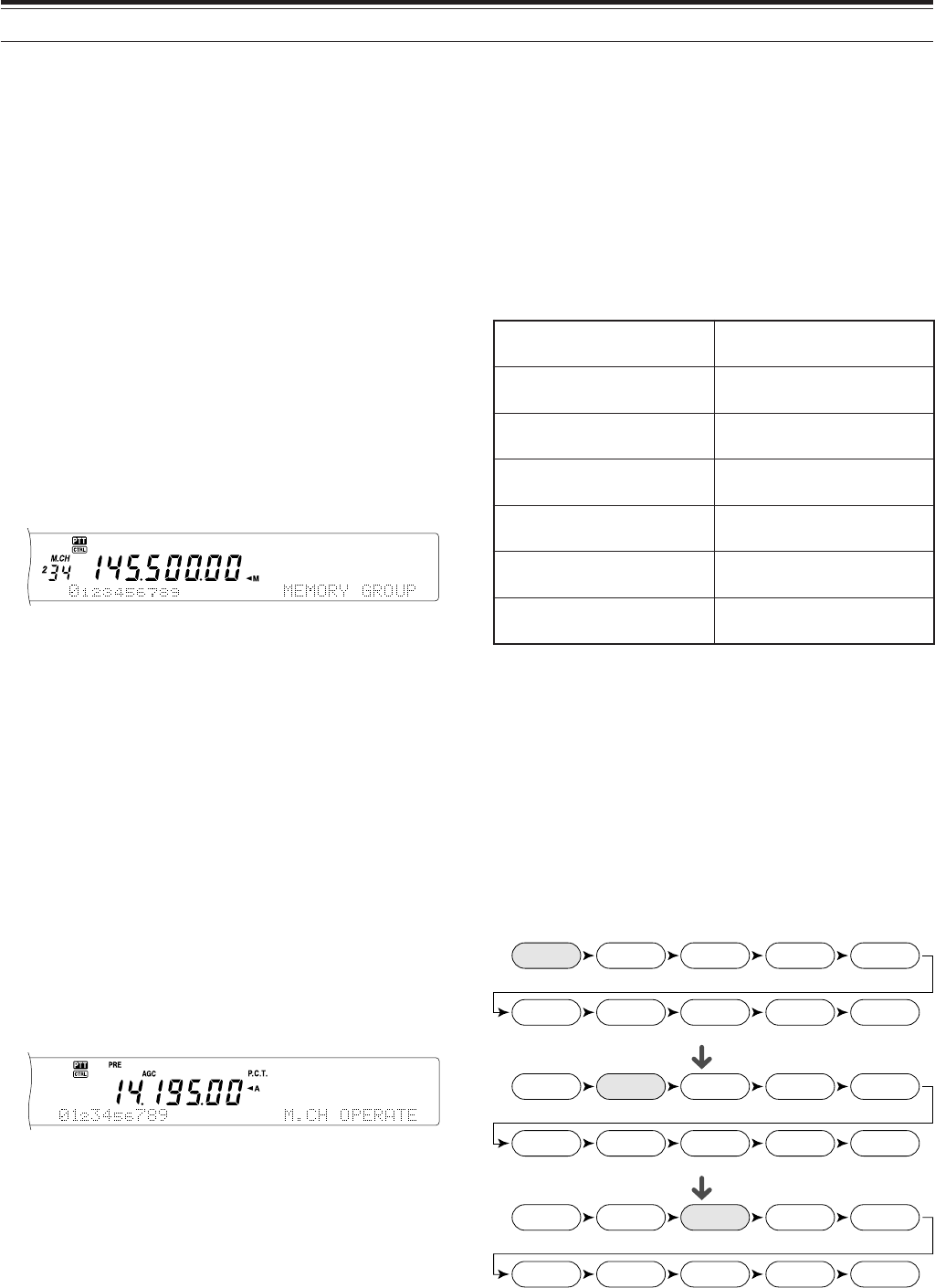
64
13 MEMORY FEATURES
MEMORY GROUP
To manage 300 memory channels, you can divide
them up into a maximum of 10 groups (Groups 0 to 9).
After you configure a Memory Group, you can select
one or more of the Memory Groups you want to recall,
in Memory Recall mode. As a default, all memory
channels are stored in Group 0.
To change the Memory Channel Group:
1 Press [M.IN] to enter Memory Scroll mode.
2 Select the desired memory channel for which you
want to change the Memory Group by turning the
MULTI/ CH control.
3 Press [DISP].
• The Memory Name input prompt appears.
4 Press [DISP] again to skip the input or enter a
Memory Name using [+]/ [–] and [MAIN] or [SUB]
{page 63}.
• The current Memory Group appears in a larger
font.
5 Press a numeric key to change the selected
Group number. The newly selected Group
number appears in a larger font.
6 Press [M.IN] to store the settings.
■ Memory Group Select
After you configure Memory Groups to the Memory
Channels, you can select one or more of the Groups
to be recalled in Memory Recall mode.
To select Memory Groups:
1 Press [FUNC], [M
ss
ss
sVFO/ MG.SEL] to enter
Memory Group Select mode.
2 Numbers 0 ~ 9 appear in the main dot-matrix
display. The selected Memory Group numbers are
displayed in larger fonts. To change the selection,
press a numeric key. To select all the Memory
Groups, press [•/ DCS/SEL]. At least, one
Memory Group must be selected.
3 Press [M.IN] to save the setting and exit.
4 You can now recall only the selected Memory
Groups in Memory Recall mode.
QUICK MEMORY
Quick memory is designed to quickly and temporarily
save data without specifying a particular memory
channel. Use Quick memory to store data you will
not use in future operating sessions. For example, as
you tune across the band looking for DX, it is
convenient to store stations that you want to contact.
You can quickly jump between several different
memory channels as you monitor them.
This transceiver provides ten Quick memory channels
(“0_” to “9_”) that can store the following data:
dnaycneuqerfAOFV
edomgnitarepo
dnaycneuqerfBOFV
edomgnitarepo
FFO/NOreviecer-buS
ycneuqerfreviecer-buS
edomgnitarepodna
FFO/NOTIRFFO/NOTIX
ycneuqerftesffoTIX/TIRhtdiwdnabretlifrevieceR
FFO/NOreknalBesioNFFO/NOENIF
noitcudeResioNPSD
2/1/FFO
lecnaCtaeBPSD
FFO/NO
hctoNotuAPSD
FFO/NO
snoitcnufXR/XT
STORING INTO QUICK MEMORY
Each time you store a new frequency, all previously
stored frequencies are bumped to the next respective
Quick memory channel. When all ten memory
channels contain frequencies, storing one more
frequency bumps the contents of memory channel 9
off the stack (the data is lost).
The following diagram illustrates how the Quick
Memory stacks the data in memory each time you
press QUICK MEMO [M.IN].
24.911
Memory 0
144.005
Memory 1
14.235
Memory 2
441.250
Memory 3
18.111
Memory 4
50.015
Memory 5
7.082
Memory 6
29.610
Memory 7
3.545
Memory 8
145.250
Memory 9
21.005
Memory 0
24.911
Memory 1
144.005
Memory 2
14.235
Memory 3
441.250
Memory 4
18.111
Memory 5
50.015
Memory 6
7.082
Memory 7
29.610
Memory 8
3.545
Memory 9
14.085
Memory 0
21.005
Memory 1
24.911
Memory 2
144.005
Memory 3
14.235
Memory 4
441.250
Memory 5
18.111
Memory 6
50.015
Memory 7
7.082
Memory 8
29.610
Memory 9
New data
New data
New data
Note: To use the Quick memory channels, you must operate both
the main transceiver and the sub-receiver in VFO mode. If you are
using the Quick memory channels while the sub-receiver is turned
off, its last operating mode must be VFO mode. Turning the
sub-receiver off while it is recalling a memory channel will not allow
you to use the Quick memory function.


















